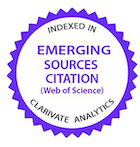CLIMATE SPATIALIZATION AND GENOTYPE-ENVIRONMENT INTERACTION EFFECTS ON WEANING WEIGHTS OF NELLORE CATTLE IN EXTENSIVE SYSTEMS IN TROPICAL REGIONS OF BRAZIL
DOI:
https://doi.org/10.1590/1089-6891v18e-39597Keywords:
Animal breeding, canonical correlation, cluster, heritability, ZebuAbstract
Depending on the environmental differences among the regions, the phenotypic expression in beef cattle may significantly vary between the progenies of the same sire, and this is an important rule to identify the best animal. Thus, this study was carried out to spatialize environmental factors that may help to compare and discriminate the states of Maranhão, Pará, and Tocantins and also to check for genotype x environment interaction (G x E interaction) in these regions. The environmental variables analyzed were: maximum temperature; minimum temperature; mean temperature; precipitation; normalized difference vegetation index; relative humidity; altitude; and index of temperature and humidity. Records of weaning weight of Nellore cattle raised on pasture were collected between the years of 1997 and 2007. The dataset was constituted of 21.117 animals, progenies of 161 sires. (Co)variance components and breeding values were estimated using the multiple-trait derivative-free restricted maximum likelihood method. Multivariate spatialization revealed clear distinction among the States of Maranhão, Pará, and Tocantins and allowed the identification of important environmental variables for discrimination. The estimate for direct heritability showed moderate magnitudes and were 0.22±0013, 0.26±0.021, and 0.29±0023, for the States of Maranhão, Pará, and Tocantins, respectively. The estimates of correlation between the breeding values, predicted in different States, as well as the genetic correlation for weaning weight showed that sire ranks changed among the States, indicating G x E interaction. There was a variation of the genetic response of the progeny, depending on the sire and on the State. Thus, the G x E interaction should be accounted for in the genetic evaluation of sires and the performance of Nellore cattle under extensive breeding systems in tropical regions of Brazil.Keywords: animal breeding; canonical correlation; cluster; heritability; Zebu.
Downloads
Download data is not yet available.
Published
2017-03-31
How to Cite
FERREIRA, Jorge Luis; LOPES, Fernando Brito; GARCIA, José Américo Soares; SILVA, Maria Paula Beiriz; NEPOMUCENO, Leandro Lopes; MARQUES, Ednira Gleida; SILVA, Marcelo Côrrea da. CLIMATE SPATIALIZATION AND GENOTYPE-ENVIRONMENT INTERACTION EFFECTS ON WEANING WEIGHTS OF NELLORE CATTLE IN EXTENSIVE SYSTEMS IN TROPICAL REGIONS OF BRAZIL. Brazilian Animal Science/ Ciência Animal Brasileira, Goiânia, v. 18, 2017. DOI: 10.1590/1089-6891v18e-39597. Disponível em: https://revistas.ufg.br/vet/article/view/e-39597. Acesso em: 5 dec. 2025.
Issue
Section
ANIMAL SCIENCE
License
Copyright (c) 2017 CIÊNCIA ANIMAL BRASILEIRA (Brazilian Animal Science)

This work is licensed under a Creative Commons Attribution 4.0 International License.
Authors who publish with this journal agree to the following terms:
- Authors retain copyright and grant the journal right of first publication with the work simultaneously licensed under a Creative Commons Attribution License that allows others to share the work with an acknowledgement of the work's authorship and initial publication in this journal.
- Authors are able to enter into separate, additional contractual arrangements for the non-exclusive distribution of the journal's published version of the work (e.g., post it to an institutional repository or publish it in a book), with an acknowledgement of its initial publication in this journal.
- Authors are permitted and encouraged to post their work online (e.g. in institutional repositories or on their website) prior to and during the submission process, as it can lead to productive exchanges, as well as earlier and greater citation of published work (See The Effect of Open Access).































